Debopriyo Banerjee
Llama-3-Nanda-10B-Chat: An Open Generative Large Language Model for Hindi
Apr 08, 2025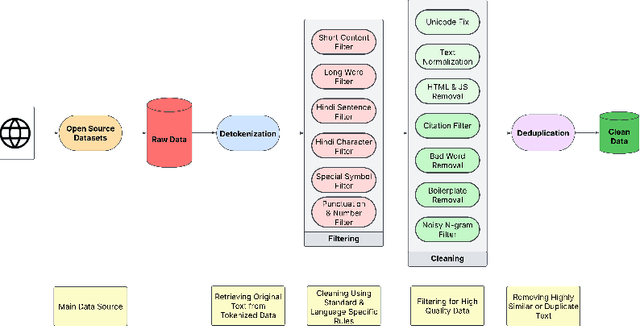



Abstract:Developing high-quality large language models (LLMs) for moderately resourced languages presents unique challenges in data availability, model adaptation, and evaluation. We introduce Llama-3-Nanda-10B-Chat, or Nanda for short, a state-of-the-art Hindi-centric instruction-tuned generative LLM, designed to push the boundaries of open-source Hindi language models. Built upon Llama-3-8B, Nanda incorporates continuous pre-training with expanded transformer blocks, leveraging the Llama Pro methodology. A key challenge was the limited availability of high-quality Hindi text data; we addressed this through rigorous data curation, augmentation, and strategic bilingual training, balancing Hindi and English corpora to optimize cross-linguistic knowledge transfer. With 10 billion parameters, Nanda stands among the top-performing open-source Hindi and multilingual models of similar scale, demonstrating significant advantages over many existing models. We provide an in-depth discussion of training strategies, fine-tuning techniques, safety alignment, and evaluation metrics, demonstrating how these approaches enabled Nanda to achieve state-of-the-art results. By open-sourcing Nanda, we aim to advance research in Hindi LLMs and support a wide range of real-world applications across academia, industry, and public services.
Llama-3.1-Sherkala-8B-Chat: An Open Large Language Model for Kazakh
Mar 03, 2025Abstract:Llama-3.1-Sherkala-8B-Chat, or Sherkala-Chat (8B) for short, is a state-of-the-art instruction-tuned open generative large language model (LLM) designed for Kazakh. Sherkala-Chat (8B) aims to enhance the inclusivity of LLM advancements for Kazakh speakers. Adapted from the LLaMA-3.1-8B model, Sherkala-Chat (8B) is trained on 45.3B tokens across Kazakh, English, Russian, and Turkish. With 8 billion parameters, it demonstrates strong knowledge and reasoning abilities in Kazakh, significantly outperforming existing open Kazakh and multilingual models of similar scale while achieving competitive performance in English. We release Sherkala-Chat (8B) as an open-weight instruction-tuned model and provide a detailed overview of its training, fine-tuning, safety alignment, and evaluation, aiming to advance research and support diverse real-world applications.
MATHSENSEI: A Tool-Augmented Large Language Model for Mathematical Reasoning
Feb 27, 2024



Abstract:Tool-augmented Large Language Models (TALM) are known to enhance the skillset of large language models (LLM), thereby, leading to their improved reasoning abilities across many tasks. While, TALMs have been successfully employed in different question-answering benchmarks, their efficacy on complex mathematical reasoning benchmarks, and the potential complimentary benefits offered by tools for knowledge retrieval and mathematical equation solving, are open research questions. In this work, we present MATHSENSEI, a tool-augmented large language model for mathematical reasoning. Augmented with tools for knowledge retrieval (Bing Web Search), program execution (Python), and symbolic equation solving (Wolfram-Alpha), we study the complimentary benefits of these tools through evaluations on mathematical reasoning datasets. We perform exhaustive ablations on MATH,a popular dataset for evaluating mathematical reasoning on diverse mathematical disciplines. We also conduct experiments involving well-known tool planners to study the impact of tool sequencing on the model performance. MATHSENSEI achieves 13.5% better accuracy over gpt-3.5-turbo with chain-of-thought on the MATH dataset. We further observe that TALMs are not as effective for simpler math word problems (in GSM-8k), and the benefit increases as the complexity and required knowledge increases (progressively over AQuA, MMLU-Math, and higher level complex questions in MATH). The code and data are available at https://github.com/Debrup-61/MathSensei.
BOXREC: Recommending a Box of Preferred Outfits in Online Shopping
Feb 26, 2024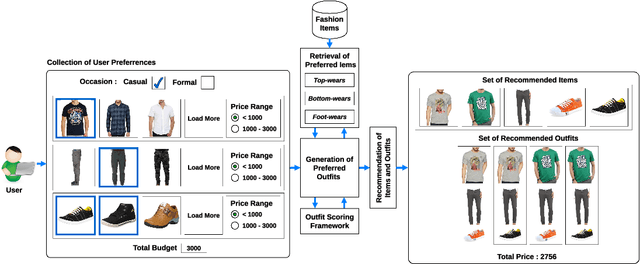
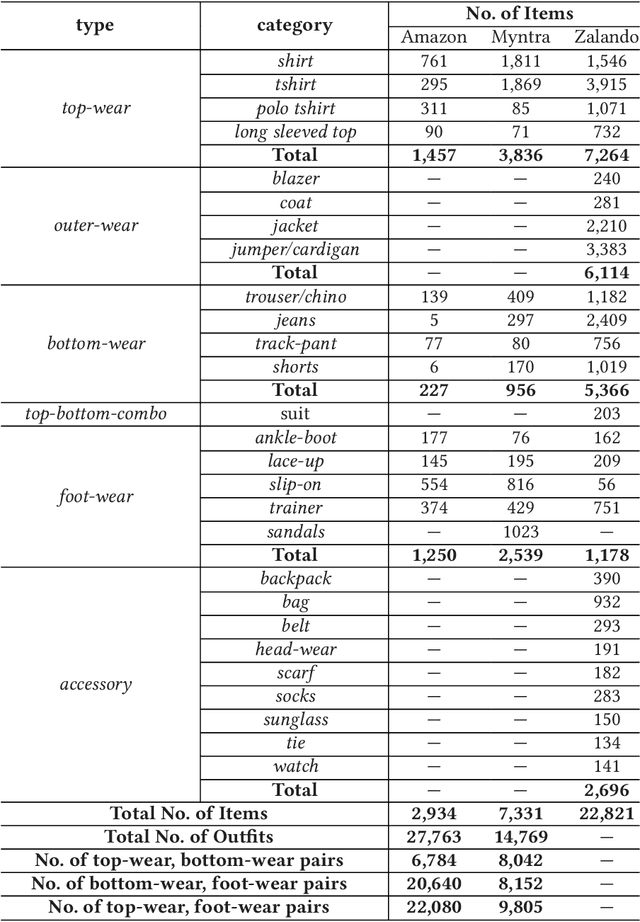


Abstract:Over the past few years, automation of outfit composition has gained much attention from the research community. Most of the existing outfit recommendation systems focus on pairwise item compatibility prediction (using visual and text features) to score an outfit combination having several items, followed by recommendation of top-n outfits or a capsule wardrobe having a collection of outfits based on user's fashion taste. However, none of these consider user's preference of price-range for individual clothing types or an overall shopping budget for a set of items. In this paper, we propose a box recommendation framework - BOXREC - which at first, collects user preferences across different item types (namely, top-wear, bottom-wear and foot-wear) including price-range of each type and a maximum shopping budget for a particular shopping session. It then generates a set of preferred outfits by retrieving all types of preferred items from the database (according to user specified preferences including price-ranges), creates all possible combinations of three preferred items (belonging to distinct item types) and verifies each combination using an outfit scoring framework - BOXREC-OSF. Finally, it provides a box full of fashion items, such that different combinations of the items maximize the number of outfits suitable for an occasion while satisfying maximum shopping budget. Empirical results show superior performance of BOXREC-OSF over the baseline methods.
MFBE: Leveraging Multi-Field Information of FAQs for Efficient Dense Retrieval
Feb 23, 2023Abstract:In the domain of question-answering in NLP, the retrieval of Frequently Asked Questions (FAQ) is an important sub-area which is well researched and has been worked upon for many languages. Here, in response to a user query, a retrieval system typically returns the relevant FAQs from a knowledge-base. The efficacy of such a system depends on its ability to establish semantic match between the query and the FAQs in real-time. The task becomes challenging due to the inherent lexical gap between queries and FAQs, lack of sufficient context in FAQ titles, scarcity of labeled data and high retrieval latency. In this work, we propose a bi-encoder-based query-FAQ matching model that leverages multiple combinations of FAQ fields (like, question, answer, and category) both during model training and inference. Our proposed Multi-Field Bi-Encoder (MFBE) model benefits from the additional context resulting from multiple FAQ fields and performs well even with minimal labeled data. We empirically support this claim through experiments on proprietary as well as open-source public datasets in both unsupervised and supervised settings. Our model achieves around 27% and 20% better top-1 accuracy for the FAQ retrieval task on internal and open datasets, respectively over the best performing baseline.
An Application to Generate Style Guided Compatible Outfit
May 02, 2022Abstract:Fashion recommendation has witnessed a phenomenal growth of research, particularly in the domains of shop-the-look, contextaware outfit creation, personalizing outfit creation etc. Majority of the work in this area focuses on better understanding of the notion of complimentary relationship between lifestyle items. Quite recently, some works have realised that style plays a vital role in fashion, especially in the understanding of compatibility learning and outfit creation. In this paper, we would like to present the end-to-end design of a methodology in which we aim to generate outfits guided by styles or themes using a novel style encoder network. We present an extensive analysis of different aspects of our method through various experiments. We also provide a demonstration api to showcase the ability of our work in generating outfits based on an anchor item and styles.
Recommendation of Compatible Outfits Conditioned on Style
Mar 30, 2022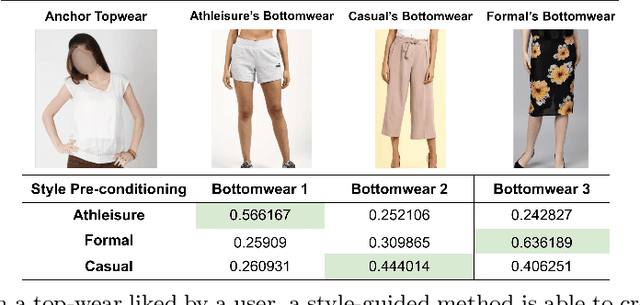

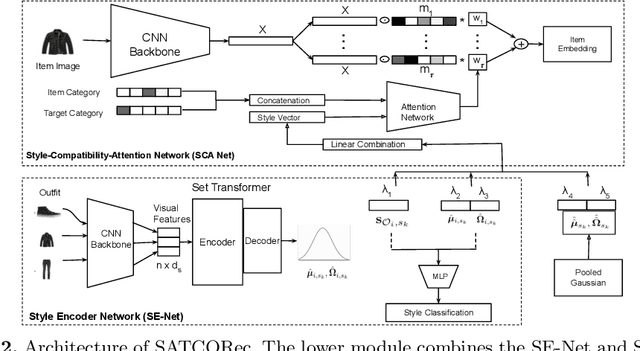

Abstract:Recommendation in the fashion domain has seen a recent surge in research in various areas, for example, shop-the-look, context-aware outfit creation, personalizing outfit creation, etc. The majority of state of the art approaches in the domain of outfit recommendation pursue to improve compatibility among items so as to produce high quality outfits. Some recent works have realized that style is an important factor in fashion and have incorporated it in compatibility learning and outfit generation. These methods often depend on the availability of fine-grained product categories or the presence of rich item attributes (e.g., long-skirt, mini-skirt, etc.). In this work, we aim to generate outfits conditional on styles or themes as one would dress in real life, operating under the practical assumption that each item is mapped to a high level category as driven by the taxonomy of an online portal, like outdoor, formal etc and an image. We use a novel style encoder network that renders outfit styles in a smooth latent space. We present an extensive analysis of different aspects of our method and demonstrate its superiority over existing state of the art baselines through rigorous experiments.
 Add to Chrome
Add to Chrome Add to Firefox
Add to Firefox Add to Edge
Add to Edge